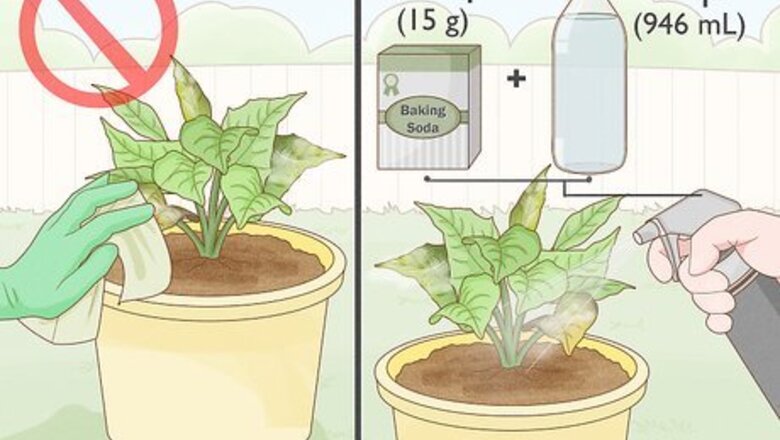
views
- Wipe mold off your houseplant’s leaves or remove the affected areas entirely with gardening shears.
- Scoop away mold on your plant’s soil with a spoon or trowel or repot it with sterile soil to keep the mold from spreading.
- Make sure your houseplant is in a well-lit space with plenty of airflow to prevent the mold from returning.
Removing Mold from Leaves
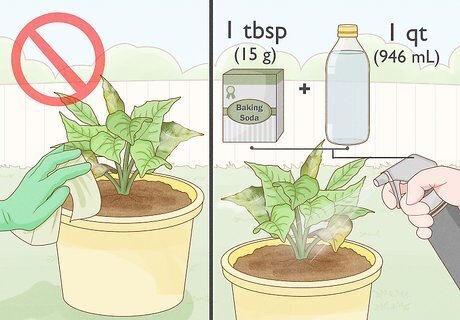
Mist leaves affected by powdery mold with baking soda and water. It may be tempting to wipe powdery mold off leaves, but don’t do it! This could easily spread mold spores and cause the mold to come back. Instead, mix 1 tbsp (15 g) of baking soda with 1 qt (946 mL) of water together in a spray bottle. Spritz both sides of the leaves thoroughly and let the excess water drip off. Some houseplant owners use a mouthwash solution to wipe down their leaves instead of baking soda. There isn't scientific evidence to prove this is more effective at removing mold, but you could try it by mixing 1 part mouthwash with 3 parts water. Powdery mold makes leaves look like they’ve been dusted with flour.
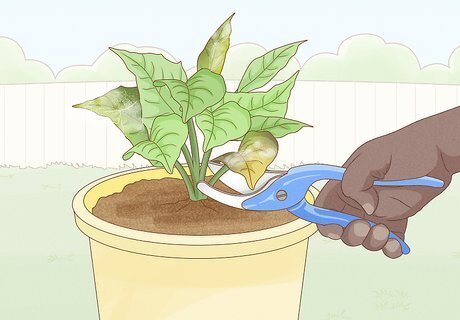
Cut off leaves affected by white or black mold with scissors or shears. Identify which leaves have mold by inspecting them thoroughly—don’t forget to check the underside! Then, use a pair of garden scissors or shears to trim the leaf at the stem. This will improve the airflow around the plant, preventing more mold from growing. Toss the moldy leaves aside and dispose of them, keeping them away from other plants. If there’s still visible mold on the leaves you wiped, cut off the leaves. White mold usually has a fuzzy texture and looks like cotton. Black or sooty mold is dark in color and usually has a splotchy pattern.

Spray your affected plant with a natural fungicide and monitor it closely. Once the mold is removed, give your plant a nice coating of fungicide spray to keep the mold from coming back. Keep spraying until beads of fungicide are running off the leaves. Wait 7 days, spray your plant again, and monitor it to see if the mold comes back. If the mold does comes back, keep the plant in a room around 70 °F (21 °C) near an open window with drier soil.

Take your plant outside to keep the mold from spreading. Bring your houseplant outside when preparing to remove mold. Cleaning the plant can cause mold spores to float through the air and infect other areas of your house. So, to be safe, place the plant outside and work on it there. Make sure set the plant down in a spot that’s away from trees and other plants, so you don’t put them at risk.
Removing Mold from Soil
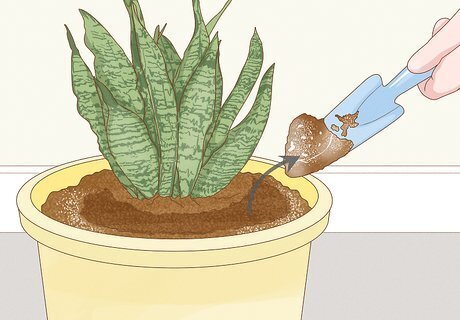
Scoop the mold away with a spoon or shovel. If you see mold on your houseplant’s soil, it’s likely confined to the top layer. Use a spoon or small gardening trowel (depending on the size of your plant’s pot) to remove the top layer of soil and lingering mold.
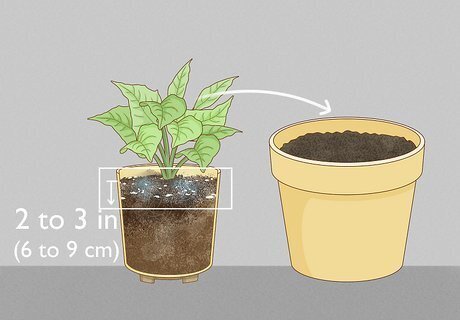
Repot your plant if there’s mold under the surface layer of soil. Mold likes to grow, travel, and spread, especially in moist, wet conditions. If you notice that there are patches of mold 2 to 3 in (6 to 9 cm) below the top layer or soil, take your plant out of the pot and repot it. Knock out at much soil from your plant’s roots as you can; otherwise, the mold may return in the new soil and cause root rot.
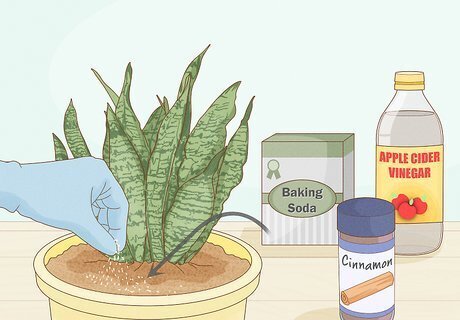
Add a natural anti-fungal to your soil to keep the mold away. This step is optional, but the mold spores will likely spread throughout the soil again if you don’t do this. Try sprinkling or spraying cinnamon, baking soda, apple cider vinegar, or neem oil on top of the soil. These ingredients naturally repel mold without harming your houseplant. Mist the plant’s leaves, stem, and soil with a cinnamon spray made by dissolving 1 tbsp (15 g) of cinnamon in 1 c (237 mL) of warm water. Cover the soil around your plant’s stem with a dusting of baking soda to stop mold from growing. Spray a solution of 2 tbsp (30 g) of apple cider vinegar with 1/4 gal (946 mL) of water to kill traces of mold on and around the plant, as the antimicrobial properties of apple cider vinegar are antifungal. Spritz neem oil around the base of your plant generously to stop mold from spreading.
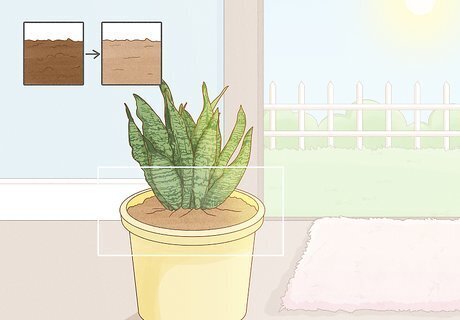
Let the soil dry before watering again. Poke your finger in the soil every few days. Once it’s dry 2 to 3 in (6 to 8 cm) down, it’s time to water. Water slowly to let the water sink and drain through the soil, stopping once water is flowing out of the pot’s drainage holes. Only drying the soil when it’s wet can stop any lingering mold spores from growing as there will be no moisture to latch onto. If your houseplant requires moist soil, wait until the top layer or surface is dry.
Preventing Further Mold Growth
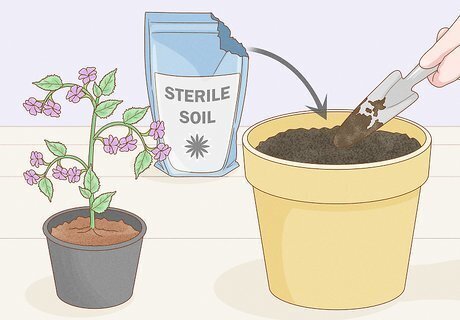
Pot your plant with sterile soil. The right soil can help prevent mold from growing and spreading in the future. Always repot new and owned plants in a sterile soil, as these have been treated with heat or chemicals to lessen the amount of bacteria in the soil. This way, you keep any unwanted mold spores from contaminating the new pot. Choose a soil that fits your plant’s needs. For instance, potting mixes are generally used to pot houseplants because they have a light texture and high drainage.

Place your plant in a well-lit environment with good airflow. Mold grows on houseplants when there isn’t enough light or ventilation, so make sure your houseplant has plenty of sunshine, airflow, and space to grow. Move your plants to a well-lit room, open windows, place an oscillating fan near your plants, and don’t put too many plants in one pot. Implementing these simple things prevents not only mold growth but also helps your plant thrive. Powdery mildew or mold, also known as Erysiphe diffusa, can appear on the upper leaf of a plant when not enough light is present. Black mold, also known as Stachybotrys chartarum, can grow on the soil and surfaces around the plant when it’s overwatered. White mold, also known as Sclerotinia stem rot, can effect the leaves and tissues of houseplants in humid conditions.
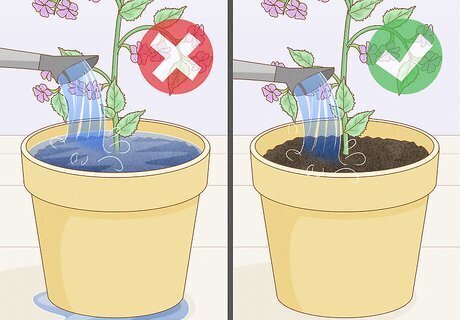
Water your plant only when necessary. Over-watering your houseplants can lead to mold problems. Always check that the top layer of soil is dry before watering, especially since each plant type requires different amounts of water. Sometimes, the soil takes longer to dry than normal, and that’s okay! Test the dryness of the soil with your finger before watering, rather than following a strict watering schedule. Along with this, make sure the pot has drainage holes that let excess water flow out of the soil. Some houseplant owners pour lemon juice on the top layer of soil after watering to prevent mold from returning. Although lemon juice is proven to have some antimicrobial properties, this hack hasn’t been scientifically tested.
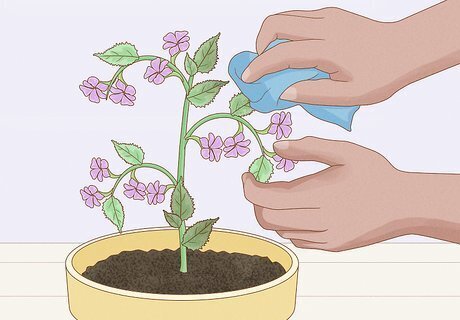
Keep your plant and pot clean. Dead and decomposing leaves and dust can cause mold problems, so make sure to remove them. Trim away dead parts of your plant, and regularly wipe down the leaves with a damp cloth. Keep your houseplant collection manageable. Sometimes less is more, especially when it comes to having the time to care for each plant properly.
















Comments
0 comment